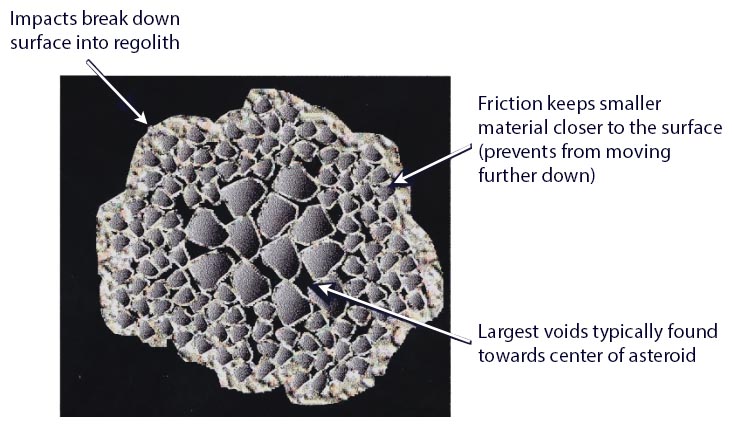Rubble Pile Asteroid

A type of asteroid held together by friction and mutual gravitation consisting of loose jumbled rock fragments from potentially different parent bodyThe body from which a meteorite or meteoroid was derived prior to its ejection. Some parent bodies were destroyed early in the formation of our Solar System, while others like the asteroid 4-Vesta and Mars are still observable today. Click on Term to Read More sources, and often containing large voids. Rubble pile asteroids can can contain material accumulated from many previous collisions with disparate geologic histories. During these collissions and other impacts, the surface of the asteroid will become regolithMixture of unconsolidated rocky fragments, soil, dust and other fine granular particles blanketing the surface of a body lacking an atmosphere. Regolith is the product of "gardening" by repeated meteorite impacts, and thermal processes (such as repeated heating and cooling cycles). Click on Term to Read More. For example, when the asteroid 2008 TC3 fell to Earth as the meteoriteWork in progress. A solid natural object reaching a planet’s surface from interplanetary space. Solid portion of a meteoroid that survives its fall to Earth, or some other body. Meteorites are classified as stony meteorites, iron meteorites, and stony-iron meteorites. These groups are further divided according to their mineralogy and Click on Term to Read More Almahita Sitta, many different types of meteorites were found including but not limited to various ureilite types, EH chondritesChondrites are the most common meteorites accounting for ~84% of falls. Chondrites are comprised mostly of Fe- and Mg-bearing silicate minerals (found in both chondrules and fine grained matrix), reduced Fe/Ni metal (found in various states like large blebs, small grains and/or even chondrule rims), and various refractory inclusions (such Click on Term to Read More and even a bencubbinite. Many of the smaller asteroids are thought to be rubble piles based on their densityMass of an object divided by its volume. Density is a characteristic property of a substance (rock vs. ice, e.g.). Some substances (like gases) are easily compressible and have different densities depending on how much pressure is exerted upon them. The Sun is composed of compressible gases and is much Click on Term to Read More being (much) lower than ice or various meteorite types. Due to their loose composition and self-gravity, rubble pile asteroids cannot spin faster than about one rotation every 2.2 hours in order for them to maintain their structural integrity. Said another way, any faster and they would fly apart1.






